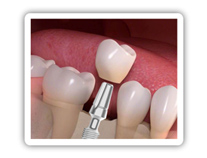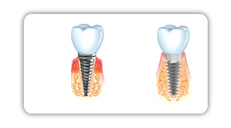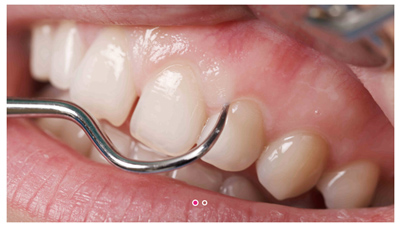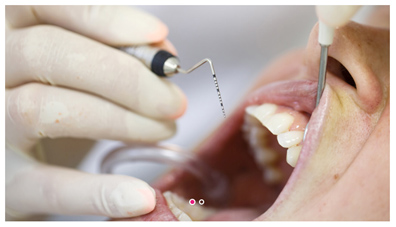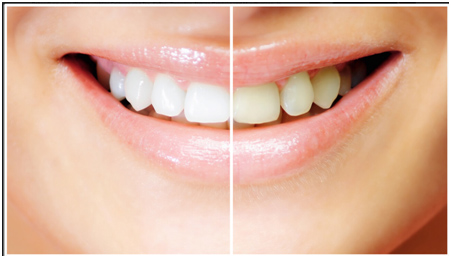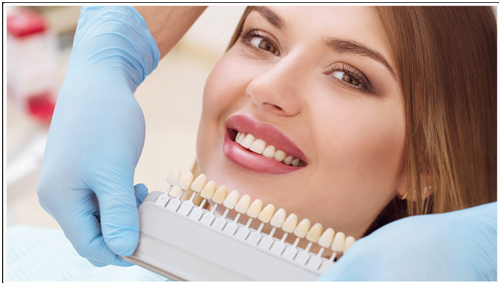Esthetic and medical dental treatments
Healthy teeth are also beautiful teeth. In our modern clinics we offer extensive treatments to restore or support dental health as well as modern dental aesthetic services:
- Dental implants: Missing or damaged teeth not only make chewing difficult, but are also perceived as unaesthetic by many patients. We complete your teeth with dental implants made of metal-free and therefore particularly compatible zirconium oxide.
- Treatment of gingivitis and periodontitis: Inflammation of the gums is caused by bacteria. If the inflammation remains untreated, it can develop into periodontitis, which can lead to tooth loss. Our experts offer you comprehensive therapies for gingivitis and periodontitis at every stage.
- Tooth root treatment: If bacteria or their toxins penetrate to the tooth nerve, the tooth root can become inflamed, sometimes painfully. The disease should be treated in order to prevent tooth loss and spread in the organism. Our specialists in endodontics perform professional root and canal treatments with the greatest precision and thoroughness.
- Teeth whitening (bleaching): For bright white teeth, you can undergo professional bleaching with us. For this purpose we offer tooth whitening using a silicone splint and also carry out complex combination applications of bleaching agents and light therapy.
- Veneers: Veneers made of all-ceramics are an ideal solution for patients who wish to have an even denture. The thin shells are glued directly to the tooth fronts and thus reliably cover tooth gaps and malpositions, discolorations or tooth fractures. The natural tooth substance is protected.
Since health insurance companies in Germany often only pay for basic dental and aesthetic dental treatment, patients often have to dig deep into their own pockets or make do with unsatisfactory standard solutions. At , on the other hand, you receive modern dental treatments with the best results.
ATTENTION: Everyone is unique. This means that the treatment process, planning and outcomes can be different for you. The information you see here is the averages encountered in a large sample size. For details please contact us via WhatsApp: +49 170 5473999
Dental services for your dental health - methods, procedure, risks
The dental specialists are specialists in dental health for all ages. In all dental treatments, they ensure that the procedures are performed to the extent necessary to restore the health of your teeth. To this end, our experts individually discuss your symptoms and discuss the appropriate treatment method with you in detail prior to the dental therapy.
Regardless of the type and scope of the dental treatment, you can expect the following services from us:
- In detailed anamnesis discussions and preliminary examinations, our dental specialists get an overview of the condition of your masticatory apparatus. Our clinics are equipped with the latest diagnostic technology for this purpose.
- Together with you, we discuss suitable treatment methods and draw up a treatment plan. At this point we also provide you with comprehensive information about possible risks and side effects of the individual methods.
- The treatments themselves take place under sterile conditions in our treatment rooms, which are equipped to the latest standards. Depending on the type and extent of the procedure, experienced dental technicians and anaesthetists are available to assist the dentist performing the procedure. The procedures are as far as possible painless.
- Following the treatment, we carry out follow-up examinations and, if necessary, any necessary after-treatments.
Since health insurance companies in Germany often only pay for basic dental and aesthetic dental treatment, patients often have to dig deep into their own pockets or make do with unsatisfactory standard solutions. At , on the other hand, you receive modern dental treatments with the best results.
Free initial consultationModern dental prosthesis with zirconium oxide dental implants
Due to illness or accidents it can happen that one or even several teeth are permanently missing in the oral cavity. The incomplete appearance, especially in the anterior region, puts pressure on the self-confidence of many people affected: They therefore want dental prostheses that not only look high-quality and natural, but also last for a long time.
We therefore use modern dental implants made of innovative zirconium oxide ceramics. Zirconium oxide is a ceramic material which convinces by many advantages and is therefore suitable for use in implant prosthetics as well as for movable dentures such as bridges and crowns:
- The material is highly biocompatible: zirconium oxide dental prostheses are very well tolerated by the body and are therefore ideal for long-term use. In contrast to conventional dental prostheses made of a ceramic-metal composite, which sometimes release harmful metal ions to the gums and discolor them, zirconium oxide is completely harmless.
- Zirconium oxide ceramics look natural: The material can be produced in our dental laboratories exactly in your tooth colour. Since the material partially transmits light, its appearance is very similar to that of natural enamel. Since no metal parts are processed here, there are no visible dark edges or discoloured transitions at the tooth edge.
- Zirconium oxide is very hard and stable over a long period of time, making the dental prosthesis corrosion-resistant and durable.
Dental implants from
Dental implants are artificial tooth roots that are implanted in the jawbone during a surgical procedure and on which a dental prosthesis made of zirconium oxide ceramics is placed. This type of dental prosthesis offers many advantages over movable full or partial dentures and bridges: The implants offer significantly more wearing comfort, prevent the jawbone from breaking down and avoid incorrect loading of the remaining natural teeth.
The implant is made of titanium and titanium alloys that are well accepted by the body tissue. The implant is completely attached to the jawbone in about 2 to 3 months and thus offers a durable and reliable dental prosthesis.
Procedure of dental implantation in
In order for esthethica implants to anchor permanently and securely in the jawbone, our surgeons with many years of experience in implantology attach great importance to thorough diagnostics and the use of high-quality implant materials. These not only guarantee a firm hold, but also prevent possible risks of inflammation and damage to the jawbone.
- Before the tooth transplantation, the general state of health of the dental space and the jawbone is determined by means of state-of-the-art diagnostics. This includes the determination of the jaw bone structure and quantity, the condition of the gums as well as the course of nerve tracts and the position of the remaining teeth at the implant site.
- Based on the diagnostic results, our implantologists will work with you to draw up a detailed treatment plan. If prior treatment of risk factors such as periodontitis is indicated, this will also be included in the treatment plan.
- The duration of dental implantation always depends individually on your personal dental situation: As a rule, the implantation of a tooth takes about 20 minutes. Depending on the desired number of implants, several sessions may also be necessary.
- Using CadCam technology, the location of the implant is recorded in detail so that our dental technicians can manufacture a suitable prosthesis directly on site.
- Dental implantations are performed under local anesthesia, so the treatment is usually painless. Swelling or pressure sensations in the implant area should also subside after 24 hours.
- After the implantation you will receive an implant identification card which proves the authenticity of the dental implant.
Risks of dental implantation
As with any surgical procedure, dental implantation also involves some risks. These risks mainly concern the process of smooth wound healing, jaw health and the durability of the implant after the procedure. Thanks to our thorough diagnostics and the use of only high-quality materials, dental implantations are usually carried out without complications.
If the dental implant is not inserted with millimetre precision in the jaw, it can lead to damage of the nerve tracts or adjacent teeth. However, our computer-assisted diagnostics enable us to produce detailed images of the oral cavity, nerve tracts and bone substance in such a way that implants can be inserted minimally invasively and precisely and risks can be minimized.
The technical literature also mentions possible inflammations and regressions of the bone and gums that can lead to the loss of the implant (osteoporosis). In order to exclude these risks, we therefore only use implants made of titanium and titanium alloys which are very well accepted by the bone and gums, do not exert any pressure on the surrounding tissue and prevent a further decline in the bone material.
High risk factors are usually present heart and kidney diseases, poorly adjusted diabetes and general problems with the oral mucosa. In these cases, a dental implant may even be contraindicated. Our experienced specialists will advise you in detail whether a dental implant is suitable for you.
Treatment of gingivitis and periodontitis
Inflammation of the gums and advanced periodontitis are characterized by sometimes painful swelling and redness of the gums and exposed tooth necks, some of which are sensitive to cold or heat. Bad breath is also often a side effect of inflammation. In the case of advanced periodontitis, tooth loss is also a problem.
Treatment of gingivitis
To prevent periodontitis and tooth loss in the first place, our experienced dentists treat gingivitis in its early stages. This often requires extensive measures on the part of affected patients in order to counteract the inflammation in the long term.
Especially the extensive treatment of gingivitis is not covered by health insurance in Germany. In most cases, only the superficial removal of deposits on teeth and gums is performed. Often, however, other problems in the mouth are responsible for gingivitis: If these are not thoroughly treated, a relapse or progressive development is likely. In the health clinics we treat your gum inflammation comprehensively and lastingly.
The treatment procedure for gingivitis
Our experienced dentists will make a thorough anamnesis of your dental situation and explain to you which measures should be taken to eliminate gingivitis. A comprehensive treatment includes among other things:
- Our specialists use special dental tools to clean your tooth surfaces of deposits and impurities. The edges of the gums and the areas of the teeth that are slightly under the gums are also thoroughly cleaned.
- If necessary, we correct or replace badly mixed fillings and dentures so that no further deposits can accumulate.
- The service also includes an introduction to correct oral hygiene: our dental experts will show you which permanent hygiene measures you can use at home to combat gingivitis. You will be taught the correct tooth brushing technique and learn how to use dental floss properly. The training also includes conscientious cleaning of partial and full dentures as well as other hygiene measures.
Treatment of periodontitis
Periodontitis (also known as periodontal disease) is the bacterial infection of the gums and periodontium. Periodontitis begins with gum inflammation (gangivitis), which can lead to tooth loss: The inflammation causes the gums to swell and so-called tooth pockets to form. These pockets can contain bacteria, which the body counteracts with an immune defence system. This ensures that the periodontium and bones are destroyed and that the teeth continue to emerge from the gums. In the worst case, tooth loss occurs.
Since periodontitis often begins insidiously, it is not noticed by those affected for a long time. If periodontitis is not treated permanently, the infection can spread not only to the mouth but also to the entire body. However, if periodontitis is detected in time, it can be treated with good results.
Treatment of periodontitis with surgery
If the disease is already well advanced and the jawbone is affected, a periodontitis operation must be performed. It is advisable to have this operation performed as part of a longer holiday, as a period of rest after the operation is conducive to the recovery process.
- During the procedure, the gums in the diseased areas are cut open, folded away and the affected tissue thoroughly removed. In addition, bone and root are ground down and cleaned.
- Any gaps are sealed with suitable filling materials during the operation. Our dentists then cover the fillings with a self-dissolving foil (regeneration membrane), which supports the healing process and promotes the build-up of bone mass.
- The gums are then sutured again and protected by a special gum bandage.
Course of the periodontitis treatment
- First, our specialists perform a detailed diagnosis of the periodontitis. For this purpose, we conduct a thorough anamnesis of your oral situation and pay special attention to the gum pockets. The pockets are probed and the degree of loosening of the teeth is measured. X-rays are also taken to determine the exact causes of tooth loosening and the condition of the jawbone.
- Depending on the degree of illness, treatment with or without surgery is recommended.
- You should refrain from drinking alcohol, cigarettes and stimulating drinks such as coffee and tea even before the planned operation and also interrupt the intake of blood-thinning agents. In addition, you should already pay attention to meticulous oral hygiene before the operation.
- The surgical treatment of periodontitis takes between 45 minutes and 1 hour per mouth region and is performed under local anesthesia. If necessary, several sessions are necessary.
Risks of periodontitis surgery
Surgical procedures for the treatment of periodontitis are generally considered to be low-risk procedures. As with any operation, however, the occurrence of complications cannot be completely ruled out in this case. These mainly concern possible complications in wound healing. Of course, our specialists will inform you about all risks during the preliminary consultation for the periodontitis operation.
The surgical treatment of periodontitis usually leads to the gums receding to the still healthy part of the bone. In individual cases, the result cannot be convincing from a cosmetic point of view, especially in the anterior region. With appropriate aesthetic dentistry treatments, we offer you various possibilities to improve the aesthetic appearance of your teeth.
Treatment of periodontitis without surgery
If periodontitis is still at an early stage, it can usually be corrected without a major intervention. Our dentists use special dental instruments such as curettes, lasers and ultrasound equipment to thoroughly remove deposits below the gumline, on the surfaces of the tooth necks and roots. The surfaces that can be reached are then smoothed to make new deposits more difficult. The treatment is carried out under local anaesthesia.
Root canal treatments - procedure and risks
A tooth root treatment (endodontics) is always necessary when bacteria have caused inflammation of the tooth nerve (pulpitis). The tooth nerve - also known as pulp - is located inside the tooth and encloses blood and lymph vessels, dentin-forming cells and the nerve fibres of the tooth. The pulp is connected to the jaw via a small opening in the tooth root, thus ensuring constant blood circulation.
The inflammation can be caused by chemical as well as physical reasons: Ground teeth or cracks in the tooth caused by falls or grinding of the teeth are just as much a part of this as leaking filling and crown edges or caries infestation. In all cases, bacteria or their toxins can penetrate the dental nerve and ignite it. If the pulpitis remains untreated, the tooth nerve can die completely. More far-reaching, however, is the fact that the inflammation spreads to the surrounding periodontium and can be spread throughout the entire organism via the bloodstream.
The inflammations are treated in our health centres with classical root canal treatment. If required, we also offer root tip resection, which requires surgical intervention. Thus, in our treatment centres we exhaust all possibilities to stop root inflammations and to preserve the tooth.
Tooth root treatment by experienced dentists
If one or more tooth roots are affected, our specialists first carry out a tooth root treatment. The therapy requires a lot of experience and sure instinct in order to reach the branched root canals precisely. Our dentists have many years of experience in root canal treatment and can therefore achieve clean and lasting results even in difficult situations.
Procedure of a root canal treatment
- Before the treatment, our dentists take a thorough anamnesis and discuss the treatment plan with you based on it.
- Next, an access to the pulp is made. The specialists in our team use state-of-the-art special tools to gently open the root of the tooth.
- If access is available, the affected root canal is thoroughly cleaned with antibacterial solutions and rinsed out. This is to kill bacteria and remove diseased tooth tissue.
- The root canals are then closed with a special filling. If the inflammation reoccurs, we carry out a revision treatment and clean the affected tooth root again.
- If the renewed treatment does not yet show the desired result, the inflamed root can be surgically removed in a root tip resection.
- The treatment is carried out under local anaesthesia. Nevertheless, a slight sensation of pain may occur for a short time. Our specialists will make sure at all times that the procedure is as pleasant as possible for you.
- Depending on the extent of the necessary measures, the treatment can be spread over several sessions and takes about 1 hour each.
- Already before the treatment you should avoid stimulating drinks such as coffee or tea, do not smoke and also stop taking blood-thinning medication.
Risks of root canal treatment
The process of root canal treatment is a strain on tissue and tooth. In order to keep it as small as possible, we recommend that you plan for sufficient convalescence time after the procedure, refrain from chewing particularly hard food and pay particular attention to thorough dental hygiene. Our dentists will be happy to advise you. These risks and side effects can accompany root canal treatment:
- For a few hours or days after the procedure, the healing process can be accompanied by mild to moderate pain.
- Difficult to reach root canals in anatomically demanding branches can cause re-inflammation.
- Swelling or abscesses can occur on the surrounding gums.
- The root-filled tooth can splinter or break off.
- Even if the root is initially successfully treated, new inflammations can occur, which can ultimately only be alleviated by removing the tooth.
- The treated tooth can turn greyish or reddish after the therapy. For this purpose we offer you effective methods for tooth whitening in our houses.
Aesthetic dentistry
Our team for dental aesthetics consists of experts with many years of practical experience in various cosmetic dental treatments. A treatment plan will be discussed with you for all procedures, which will clearly show the way to your desired smile. Our specialists will discuss your individual dental situation in detail and also consider any necessary dental health procedures.
Regardless of the type and scope of the dental cosmetic treatment, you can expect the following services from us:
- Using modern diagnostic technology, our dental specialists first obtain an overview of your teeth and the condition of the masticatory apparatus. On the basis of the results, the materials and extent of the planned dental cosmetic therapies can be precisely determined.
- Thanks to state-of-the-art imaging technology, we can simulate the desired result on the computer. Here you already get a first impression of your desired smile and can have changes and adjustments made or discuss further options with the treating specialist in advance.
- We always inform you comprehensively about possible risks and side effects of cosmetic dental treatments. Should your tooth base contraindicate the desired procedures, we will work with you to find a gentle alternative.
- The procedures are painless and, if necessary, trained anaesthetists are available for local anaesthesia.
Veneers - zirconium oxide veneers
Veneers are ideal for patients who want to achieve an even smile with a fast and minimally invasive method. The wafer-thin veneers (0.3 to 0.7 mm) are simply glued to the visible tooth surfaces and reliably cover discolorations, tooth misalignments or broken teeth. Even large tooth gaps (diastema) can be satisfactorily veneered with suitable veneers.
We use veneers made of zirconium oxide, which offers numerous advantages:
- The material has very good biocompatibility: The veneers are not only well accepted by the organism, but also do not burden it with harmful washout during prolonged wear, as is often observed with conventional bridges or crowns made of a ceramic-metal composite.
- The zirconium oxide veneers can be produced in the desired tooth shade and can hardly be distinguished from natural tooth fronts in the mouth. This is achieved not least by their partial light transmission, which is very similar to that of natural enamel.
- Zirconium oxide is very hard and therefore very durable. The shells are corrosion-resistant even under heavy use and have a service life of 10 to 20 years.
- No deposits can form on the zirconium oxide ceramic, which could lead to gingivitis or other inflammatory diseases in the oral cavity. The material is also resistant to discoloration and can withstand light coffee or occasional smoking.
A further advantage of veneers over classic ceramic crowns or bridges is that the tooth substance is protected when they are attached. While the carrier tooth for ceramic crowns must be ground down sensitively, a minimal grinding is already sufficient for the restoration with well adhering veneers. The natural tooth substance is thus almost completely preserved and is additionally protected by the veneers.
Procedure of the restoration with veneers
Before our dental specialists apply veneers to your mouth, your teeth, gums and overall oral health are thoroughly examined. If there are no contraindications such as inflamed gums or untreated periodontitis, our experts will discuss your wishes with you in detail and plan the appropriate procedure.
Our dental technicians will then take an impression of your teeth. By means of modern model analysis, an exact actual condition of your teeth can be determined and the individual tooth position can be fully taken into account during the production of the veneers in our in-house laboratory. The model is discussed with you and only when you are 100% satisfied do we begin the actual treatment.
To do this, we minimally grind the teeth in question and first put the veneers on trial. If the fit is not yet perfect or if the overall esthetic appearance is not completely correct, our dental technicians make adjustments. Only when the veneers fit perfectly and also visually meet your expectations are they fixed with modern special adhesive. The entire treatment takes no longer than approx. 40 minutes.
Risks
The use of veneers to veneer discolorations, faulty tooth positions or damaged teeth is usually painless and very low-risk, serious complications do not usually occur. Possible risks can almost be excluded by the professional application of veneers:
- Veneers can occasionally fail. However, we use modern and reliable adhesive that adheres the veneers firmly to the tooth front. Should a veneer come loose, it can be applied again without any problems and pain.
- If there is an unexpected case of tooth disease or gingival regression, the veneers can tear due to the changed adhesive base. In such cases, however, the cracks can easily be closed with filling material in the same colour.
- Excessive coffee or tea consumption as well as smoking can lead to discoloration of the veneers in the long term. However, the surrounding natural tooth fronts often discolour more quickly, which can result in an a lly uneven tooth appearance. If you abandon these habits after using veneers, you will make a significant contribution to the service life of modern veneers.
Teeth whitening (bleaching)
An even and radiant smile is always determined by the colour of the teeth. Yellowish or greyish discoloured teeth or rows of teeth can cloud the smile and gnaw away self-confidence. These discolorations, which are perceived as unaesthetic, develop in the course of time through the consumption of coloring drinks such as red wine, coffee or tea as well as through smoking: The colour particles penetrate into the tooth enamel and cannot be removed even with thorough dental care.
- Discoloration of the teeth can also be caused by taking certain medications. These include, for example, nitrate or iron-containing therapeutics that stain the teeth yellowish-brownish. After a successful root canal treatment, greyish and also reddish discolorations can occur on the affected tooth. Thanks to modern tooth aesthetic methods for tooth whitening, no one has to accept this nowadays.
Our dental aestheticians offer you effective methods that can whiten your teeth by up to 8 shades depending on the degree of discoloration and your wishes. Bleaching methods in our beauty centres
In bleaching, the colour particles in the enamel are whitened by bleaching agents containing carbamide or hydrogen peroxide. Depending on the composition of the bleach and the extent of the discoloration, there are different bleaching methods to achieve the desired result.
Tooth whitening in the office bleaching procedure
The office bleaching procedure has its name from the fact that it is carried out in the "office" in one of our dental practices:
- First, the gums are covered with a stretch rubber blanket.
- The bleaching agent is then applied evenly to the teeth by a specialist experienced in the method. Depending on the desired degree of whitening, the bleaching agent is left to act on the teeth for some time.
- For a more intensive bleaching result, the effect of the agent can be enhanced by treatment with LED light or laser.
- Depending on the desired result, the application can be repeated several times.
Teeth whitening using the home bleaching method
For all those who want to get back their white smile at home on their own, also offers tooth whitening using the home bleaching method. One of our dental aestheticians will prepare an individual bleaching tray for you, which you will fill with an appropriate bleaching agent according to the precise instructions of our experts and wear for one or more hours. The results of the procedure are visible after 2 to 6 weeks.
Teeth whitening procedure
- Before bleaching, our experienced staff will perform a thorough examination of your mouth to rule out any gum problems or untreated caries infections.
- Your teeth will then be completely cleaned with a professional tooth cleaner. In this way, the treating dentist can see how strong the discolorations actually are and which treatment method is suitable.
- Together with you, we will discuss the desired and possible degree of whiteness that you would like to achieve with bleaching.
- Depending on the type of treatment, the application itself takes about 1 to 2 hours and can be repeated in several sessions until the desired result is achieved.
- In order to prolong the life of the results achieved, colouring drinks such as coffee or tea should be avoided immediately after the treatment. The consumption of acidic foods such as oranges is also contraindicated after the treatment.
Tooth whitening risks
Teeth whitening is usually risk-free, as long as it is carried out professionally. All dental specialists therefore have a thorough education and many years of experience in the field of bleaching and tooth whitening.
Another prerequisite for bleaching without complications is a healthy oral cavity without untreated caries, periodontitis or gum problems. These risks can also occur:
- When teeth are whitened with bleaching trays, the gums may become irritated and inflamed if the trays are not seated accurately. However, this risk can be largely excluded by the custom-fit fabrication of an individual bleaching tray. In office bleaching procedures, the gums are also completely covered so that they do not come into contact with the bleaching agent.
- Immediately after bleaching, the tooth necks can react more sensitively to cold and heat. This is usually only temporary and can be quickly relieved with a fluoride gel.
- Tooth fillings cannot be bleached, which may result in visible differences in shade nuances. If necessary, however, the fillings can be renewed in the appropriate shade.

